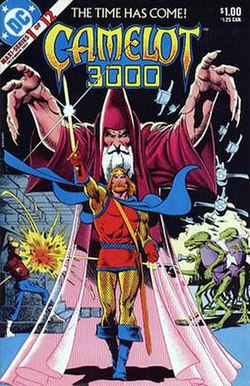Mando, Baxter, (blank)
Remember how we used to know the names of the various paper grades our comics were printed on?
Of course there was always newsprint, but its quality seemed to worsen drastically by the end of the 1970s. With the publication of DC's Camelot 3000 in 1982, the arrival of Baxter paper was hailed. It was very white and the colors were very bright. DC's learning curve was steep and the palette became far more muted by the time Lynn Varley was coloring their Thriller in 1983. Our fascination with the heavy Baxter paper lasted a few more years but it was, well, just a little too showy.
I was far more impressed with Mando paper when it came down the pike. Almost as white as Baxter but not as heavy, Mando held the color well and the image did not bleed through from the other side of the page (as had been happening with newsprint). When I would see some beautiful Don Newton artwork on Mando paper I remember thinking to myself that this was the perfect quality of paper for a comic book. But they would not leave well enough alone.
Over at Marvel Comics, the Marvel Fanfare title experimented with a glossy, slick, coated magazine stock. They described it as having every page feeling like the cover. For weeks now I have been trying to remember the name of the paper that Fanfare was printed on. It was a word that was not bandied about with the same regularity as Baxter or Mando, but I knew I had read it once or twice anyway. As I was researching to find the missing word, I found that many other individuals had struggled with locating it. I even found out from Facebook that one person in Phoenix is named Mando Baxter!
After many frustrating dead ends I did find out what that word was. It may take a while sometimes, but we do get to the bottom of things in the hayfamzone. The glossy, slick, coated magazine stock that Marvel Fanfare was printed on was called Hudson paper. Maybe I shouldn't say was. Maybe it's still called Hudson paper, and now we're getting to my point (finally, did you say?).
The vast majority of today's DC and Marvel and most other comics are printed on what I would call Hudson paper. Oh, they don't call it that. The one or two times I originally read the phrase "Hudson paper" was over twenty years ago. But (with rare exceptions) today's comics are printed on glossy, slick, coated magazine stock, and that is a tragedy.
I hate it! It doesn't look or feel like what a comic book should look or feel like! I've suffered in silence because I hadn't heard any other rumblings and I thought I was alone in my dislike for the glossiness, but no! There is a whole underground of comics fans who hate this glossy, slick, coated magazine stock for their comics! Look what I found written by Kim Thompson of Fantagraphics:
It is profoundly astonishing to me that ANYONE, let alone major publishers, is still subscribing to the weird notion that printing a comic on coated (a.k.a. glossy, a.k.a. shiny) stock is somehow fancier and better and more collectalicious. Granted that we (and Kitchen Sink and that whole generation of alternative publishers) went through that madness back in the 1980s and 1990s, we got cured eventually and realized that 98% of comics look better on uncoated stock, and NO comic looks good on outright glossy stock.So if anybody's ready to organize the revolt, I will march by your side. And if you're not sure what all this noise is about, take a look at the latest issue of Vertigo's Fables. Notice how that title, one of the few exceptions in today's world of comics, is not printed on glossy, slick, coated magazine stock. It's just a nice, white paper, equivalent in my mind to Mando paper (but nobody seems to use that phrase anymore). Imagine a paradise where all comic books are printed on that nice paper and I think you might be ready also to lace up your marching boots.


5 Comments:
I was thinking about this very topic just the other day. As I recall a big reason for the changes in the 80s was the fact that newsprint was getting so expensive that it was not much of a jump to go to the supposedly higher quality paper.
I hate the glossy stock used today and much of the photoshop gradient fills that pass for colouring. I love what DC has done with the Kirby 4th world library; a high quality paper that is reminiscent of newsprint, instead of the usual glossy stuff that gets used in TPs today.
I applaud you for the history lesson. I've been trying to find anything about Baxter paper online for years now. I am now publishing my own stuff and am about to do my first comic/graphic novel and wanted the Baxter paper I remembered my comics being printed on but when I wrote to 2-3 publishers to see about getting my book done on it, they had no idea what I was even talking about.
I also hate the new glossy comics and haven't bought one in more than 10 years now. Just don't like them or the way the art looks. I just may start the revolution back away from glossy. I'd honestly rather read comics on the old newsprint instead of on glossy paper.
Stan Lee once referred to Baxter as Baxter Text paper stock. After a bit of digging I found out it was made by Great Northern Paper. They went bust 2 months ago.
I like the heavy stock paper, but a long box filled with Baxter paper books is crazy heavy. Then add boards and bags... ohhh my back!
DC used to call that paper Miraweb.
I'm on Facebook @tntcomicsonebay
Post a Comment
<< Home